Ono-ha Itto-ryu Kenjutsu’s Yuji Yabuki on the school’s essential technique, “kiriotoshi” where angular and circular become one!
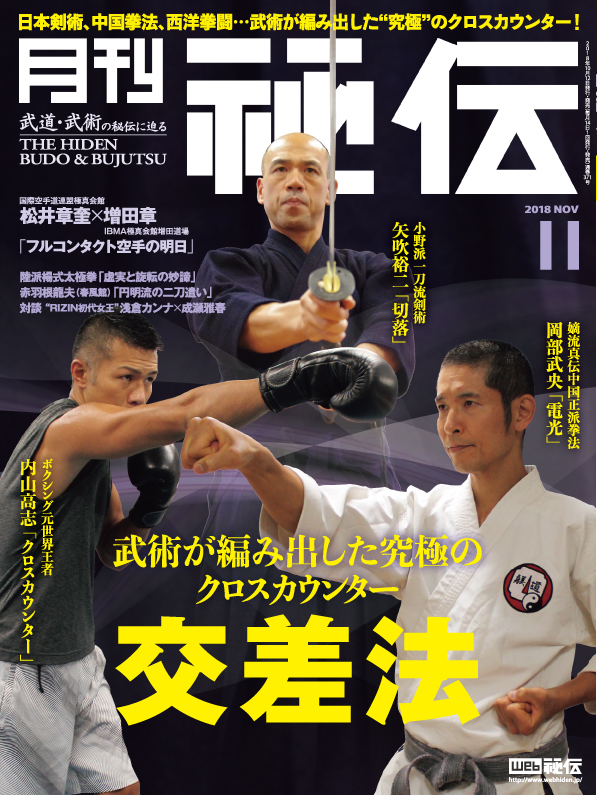 “Hiden” November 2018 issue “Cross-counter Techniques” feature
“Hiden” November 2018 issue “Cross-counter Techniques” feature
Section 3: An “invincible” technique, born in the battlefield
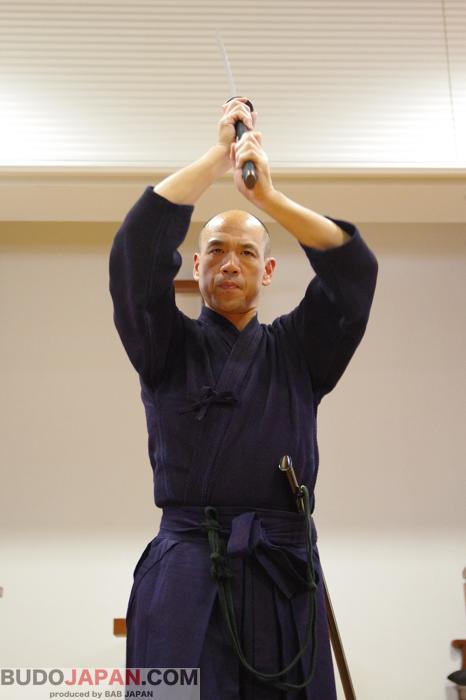 Yuji Yabuki
Yuji Yabuki
18th soke (headmaster) of Ono-ha Itto-ryu, 3rd head of the Reigakudo and 7th dan kyoshi in kendo. Born in Iwaki, Fukushima Prefecture on 10/2/1970, he became a direct student of Ono-ha Itto-ryu’s 17th soke, Takemi Sasamori sensei in 1998. On October 1, 2017 he was named the 18th soke as per Sasamori sensei’s mandate.
Original article: Satoshi Tatewaki
Translation: Grigoris Miliaresis (*)
An invincible technique from a martial tradition
Martial traditions that emerged from battlefield techniques were always searching for the basic principles that could make the difference between life and death in the techniques they would use in fighting. In a battle, the slightest disturbance in mind and body would lead to defeat and “defeat” meant death; under such severe conditions, martial arts would search for “invincible techniques”. Among them were techniques that would control the enemy’s offense while at the same time attacking. There are techniques for parrying and for counter-attacking any offense and among these techniques, the safest are those that render the opponent’s attack powerless while allowing for a simultaneous counterattack i.e. when offense and defense become one. All martial traditions were looking for the technique that would guarantee victory unifying attack and defense in one movement.
In Itto-ryu, which became the school of the house of the Tokugawa shoguns, the most characteristic offense-and-defense-as-one sword technique is “kiriotoshi”: I am meeting my opponent head-on and by cutting into his attack, his sword gets out of the way and my sword, still “alive” pierces and cuts him and I win the encounter. Because the two swords cut down each other, the situation would result in a mutual killing strike (aiuchi) but in kiriotoshi, because my sword is always the one that is “alive”, I control the enemy’s attack with my offense-and-defense-as-one sword technique. The offense-and-defense-as-one is my cross-counter; we could say that attaining this with your kenjutsu is mastering one of the school’s essential teachings.
The kiriotoshi sword technique taught in Ono-ha Itto-ryu is part of the legacy of the House of Ono that during the Edo period had provided kenjutsu teachers for the House of the Tokugawa in Edo. During the time of the fifth soke, Ono Tadakazu, it was taught to the daimiyo (feudal lord) of the Hirosaki Han (domain), Tsugaru Nobuhisa and since that time Itto-ryu became a tradition of that region, also known as Tsugaru Han. During the Showa period, Tsugaru-born Junzo Sasamori became Itto-ryu’s 16th soke and begun teaching the school at the Reigakudo dojo. From him the main line passed to the 17th soke, Takemi Sasamori and now to the 18th soke, Yuji Yabuki.
In this article we visit Reigakudo and hear from Yuji Yabuki, the 18th soke, the principle behind the kiriotoshi sword technique.
Hitotsu Gachi: the teaching of kiriotoshi
One of Itto-ryu’s core teachings is “Itto sunawachi banto, banto sunawachi itto” which can be literally translated as “one sword is ten thousand swords, ten thousand swords are one sword”.”Depending on the practitioner’s level, the interpretation of the phrase can have subtle differences but when it comes to techniques, they start and end with kiriotoshi. In Itto-ryu, the skill of kiriotoshi is studied through a series of 50 kata performed with a long sword; in this set, the first one, “Hitotsu Gachi” is the most important. “The first kata we study, Hitotsu Gachi, is the most basic –and the most difficult” says Yabuki soke, explaining the importance of Hitotsu Gachi.
In the Hitotsu Gachi kumitachi, uchikata and shikata mutually strike each other but uchikata’s sword is forced to the side and shikata’s sword, still “alive” dominates uchikata. At that moment, more important than the sword’s technique is “doing kiriotoshi to your own heart and mind”: you control your opponent going forward to meet him with a “sen-sen no sen” timing and a self-confident attitude. When the two opponents are walking towards each other, closing the distance, shikata’s sword moves with the intention to thrust the opponent and that overwhelms uchikata who, having lost the inititative, cuts to shikata’s forehead (men). Shikata, takes down this men cut with a big, round kiriotoshi. At that time, shikata’s sword traces a circular trajectory bigger than that of uchikata’s and moves on, making the tip of uchikata’s sword look like it’s splitting open; furthermore, using his stride, he moves forward as if thrusting himself in uchikata’s sword and forcing it aside. The result of this movement is that uchikata’s sword is forced to the side pushed at the shinogi (ridge) and shikata’s sword moves straight ahead completing the kiriotoshi.

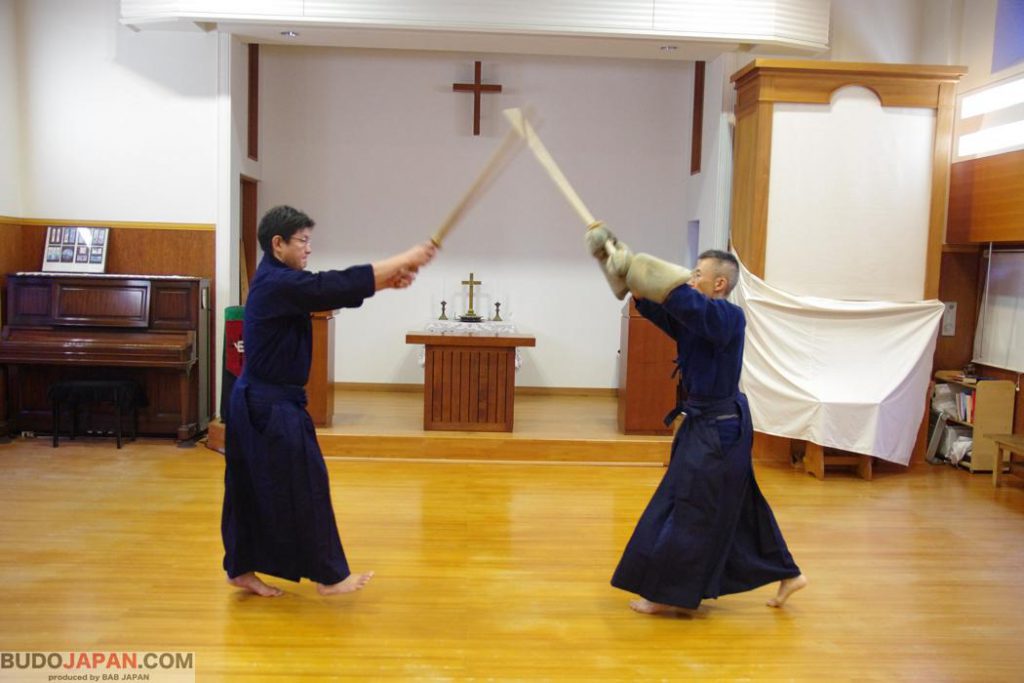
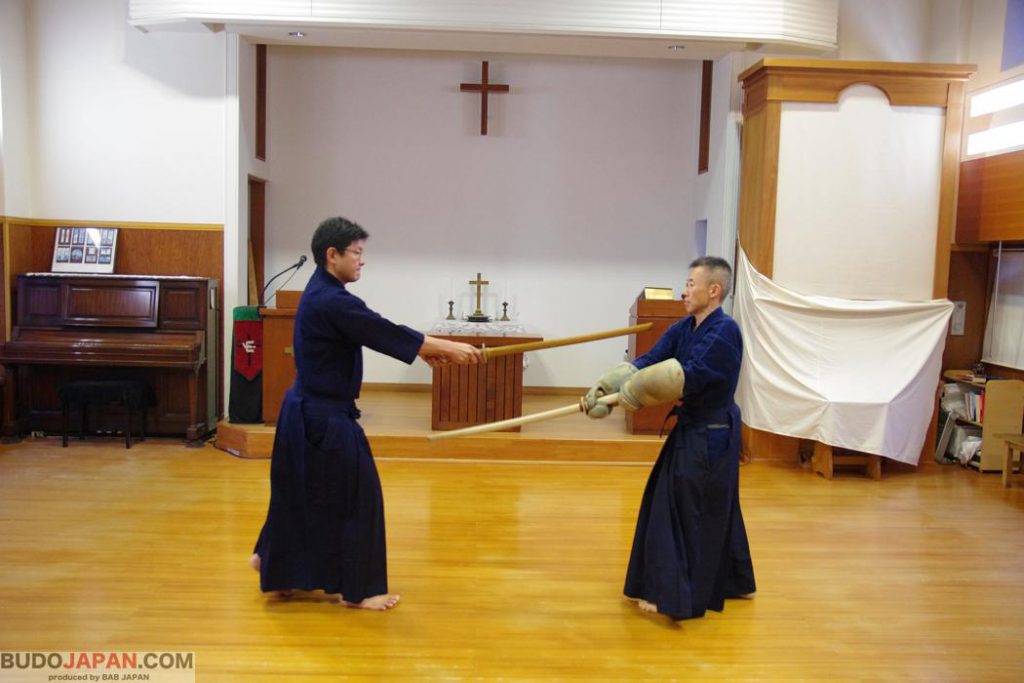
The first kumitachi, Hitotsu Gachi
Hidden in Hitotsu Gachi, is a movement where shikata’s sword is thrusting uchikata’s throat at the same time the kiriotoshi ends; what’s actually happening is that two movements (the kiriotoshi and the thrust) are happening in “one beat” so one could say that an important lesson of Hitotsu Gachi is “winning through a mutual hit in one beat”. “In kendo, after a certain amount of practice you also get to use something that looks like kiriotoshi; the difference is that in kendo, it’s an ‘uke-uchi’: whereas in Itto-ryu you win through doing two movements in one beat, in kendo you hit after receiving the opponent’s attack. And this, no matter how fast you do it, is always two movements –Itto-ryu’s technique is one. We have in Itto-ryu a teaching that states ‘One is victory, two is defeat’: we are looking for a movement that has no origin and no stop, a perfectly round movement like a circle with no beginning and no end.”
Kiriotoshi is the best example of how to condense various movements in one beat. However if both parties attack with the same intent and strength, the two swords come together in “aiki” and in that case, winning through kiriotoshi becomes difficult; therefore it’s important, before crossing swords, before the technique begins, to win over your opponent with a vigorous spirit of sen-sen no sen timing. By naturally cutting down your own heart and mind, you achieve victory through your fervor before actually engaging –this is the most important part. “Although we liken kiriotoshi to a circle, beginners often make this circle small. Their fear of their opponent makes them keep their arms close to their bodies so the swinging of the sword becomes small too. That’s why we are teaching people to use big, round movements and through the big circle that comes from them, control the opponent.
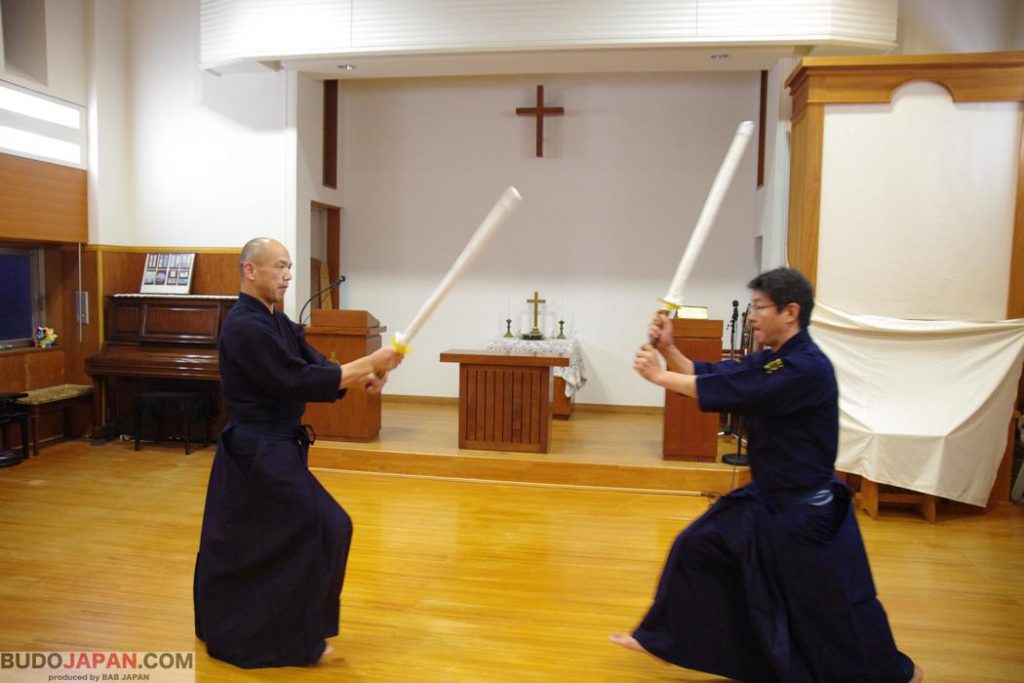
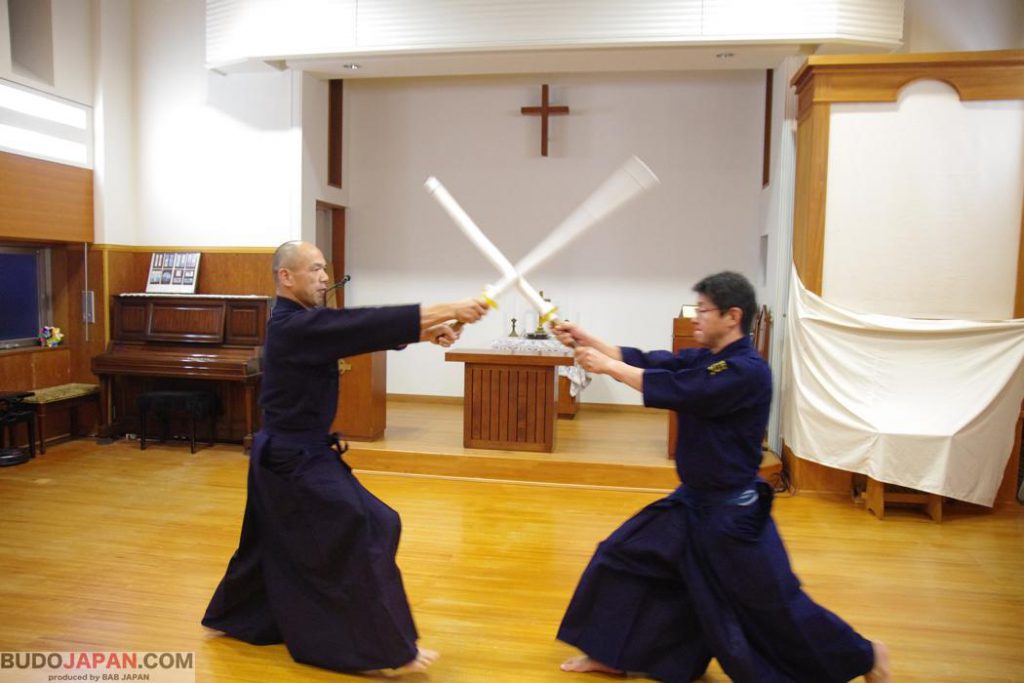
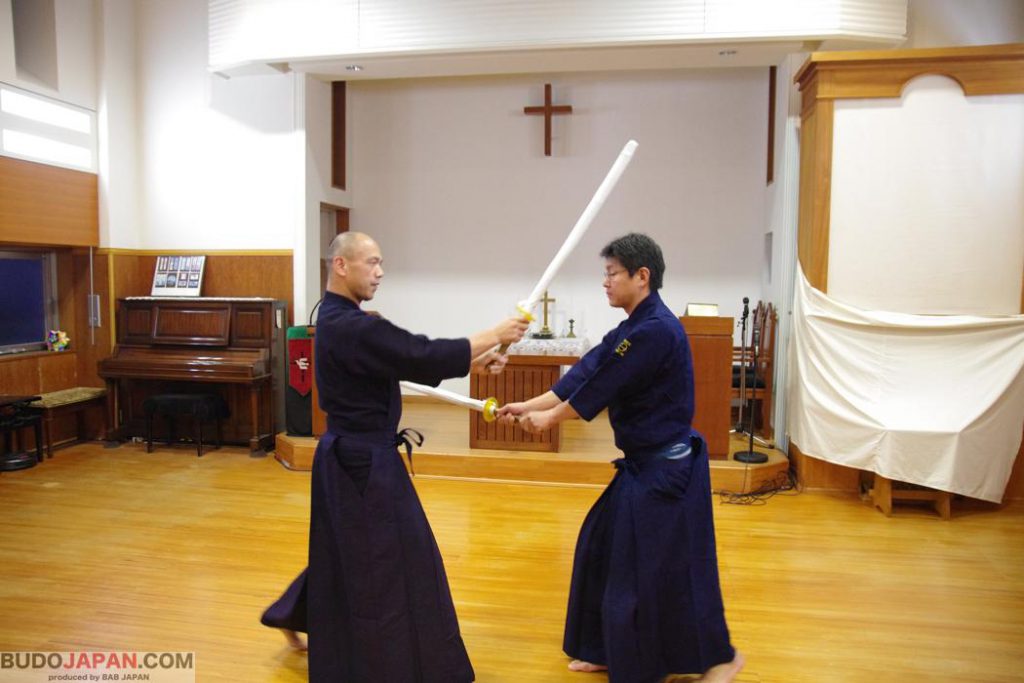
Kiriotoshi with fukuro-shinai
Rotation on the vertical and the horizontal plane
After starting with Hitotsu Gachi and the study of how to do kiriotoshi when the opponent’s sword is coming from the front, the kumitachi that follow, deal with thrusts or cuts coming from left and right. All 50 of the long sword kumitachi are a study in kiriotoshi and all 50 are a practice in how to win using kiriotoshi when confronted with various attacks.
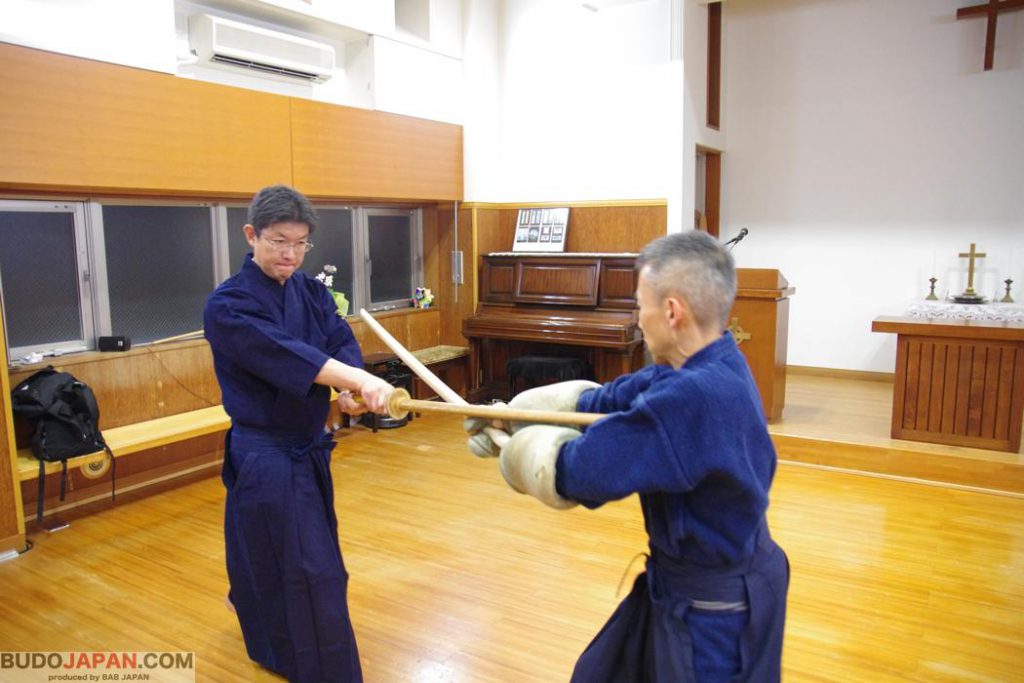 In the second kumitachi, Mukae Zuki, faced with uchikata’s thrust, shikata rotates his sword to the left and responds with a thrust of his own, winning by forcing making uchikata’s thrust to the side. In Itto-ryu the small rotating movement of the hands that can, using the swords curvature, deflect the opponent’s technique is called “manji”.
In the second kumitachi, Mukae Zuki, faced with uchikata’s thrust, shikata rotates his sword to the left and responds with a thrust of his own, winning by forcing making uchikata’s thrust to the side. In Itto-ryu the small rotating movement of the hands that can, using the swords curvature, deflect the opponent’s technique is called “manji”.
“In Itto-ryu’s teachings, there is this word ‘manji’ which is written with the character “卍” (**), referred to as “left manji”, to indicate using a rotation against your opponent’s technique. Always with a feeling of moving forward, at the moment your opponent’s sword hits you, rotate and use his force –this is what is taught- and using the manji you utilize your opponent’s force and momentum and your sword from a “dead’ sword” is transformed to a “living sword”, a life-giving sword. It is truly a formidable technique”.
The fourth kumitachi, Gedan Kasumi, is another instance where kiriotoshi employs manji. Against uchikata who is aiming for a quick cut targeting his wrist, shikata performs a quick kiriotoshi with a manji using the base of his blade, near the hand guard and that way wins. It is said that “the tip of the sword is 9cm and the base is 18cm”; this means that using that part of the blade you can exert the most force. In Gedan Kasumi, you respond to the opponent’s technique and weapon utilizing your sword tip’s 9cm and its base’s 18cm and rotating it in a manji you do kiriotoshi to his sword.
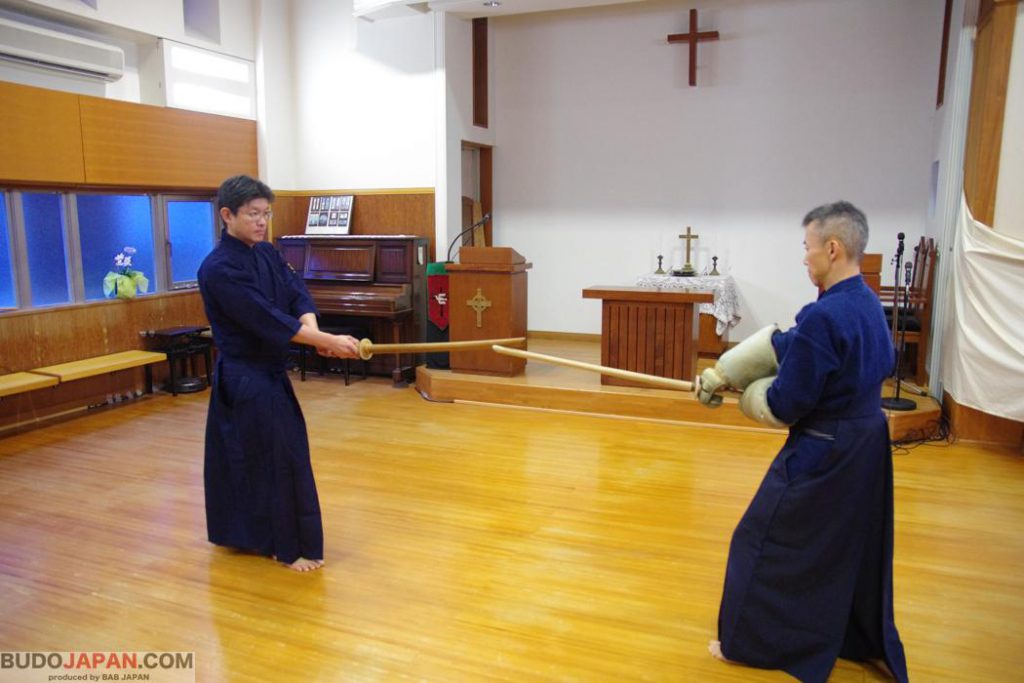
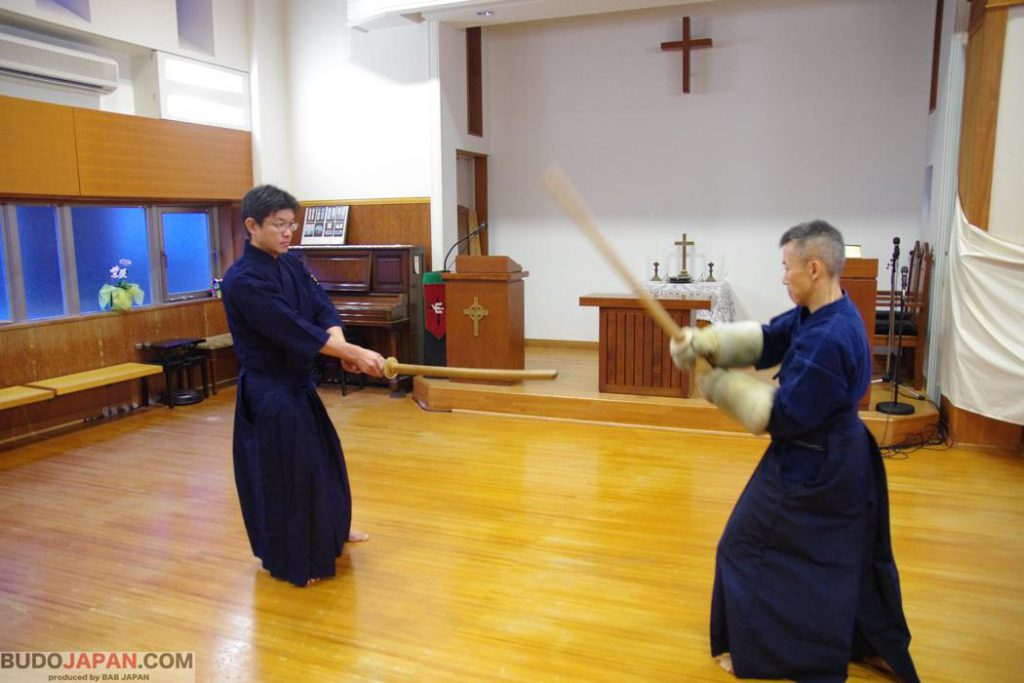

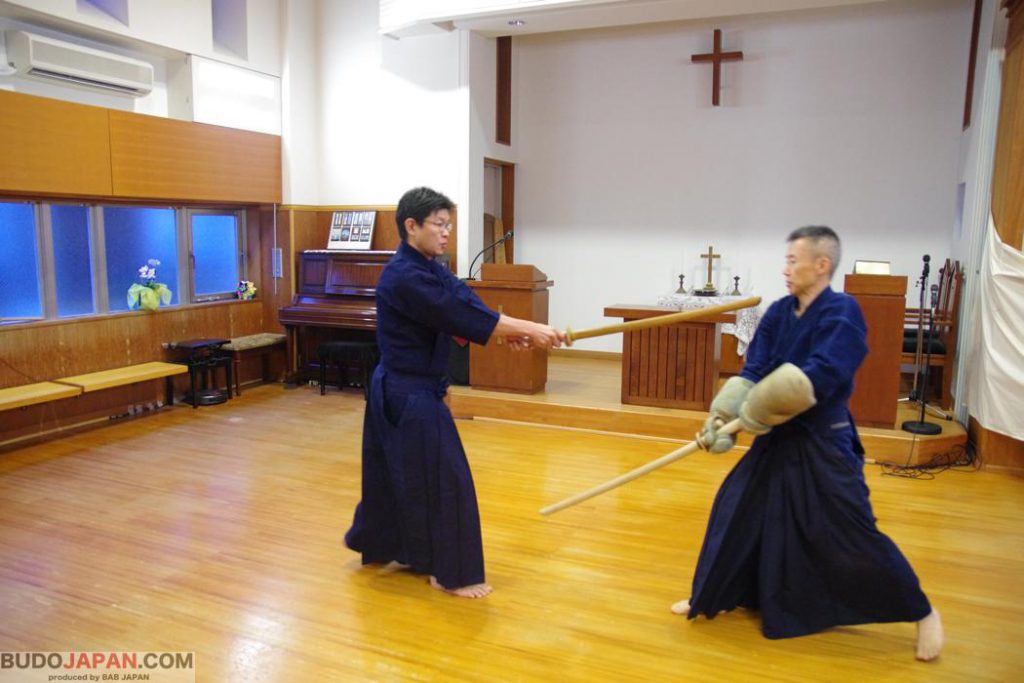
The fourth kumitachi, Gedan Kasumi
“In the third kumitachi, Tsuba Wari shikata responds to uchikata’s attack from a high, jodan position by pulling his body just enough back to allow uchikata to graze the guard of his sword. Uchikata’s sword slips to the side and shikata wins by stabbing him in the throat. In Tsuba Wari, a moment before uchikata strikes his head, shikata moves slightly back only allowing uchikata to graze his sword’s guard; if at that moment he lowers his posture fearing uchikata’s sword, he will end up having his wrist cut so he must keep his self-confidence, stay front without changing his posture and only by altering the distance allow his sword guard to get hit. This kumitachi is a mental training since shikata needs to confront his own fear of getting hit.”

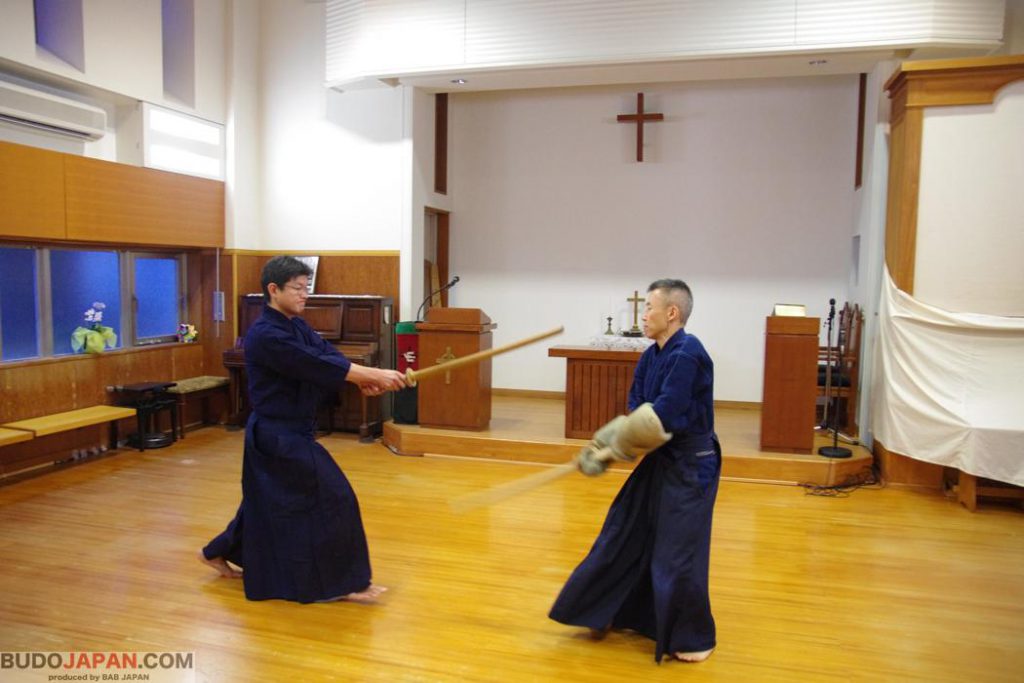
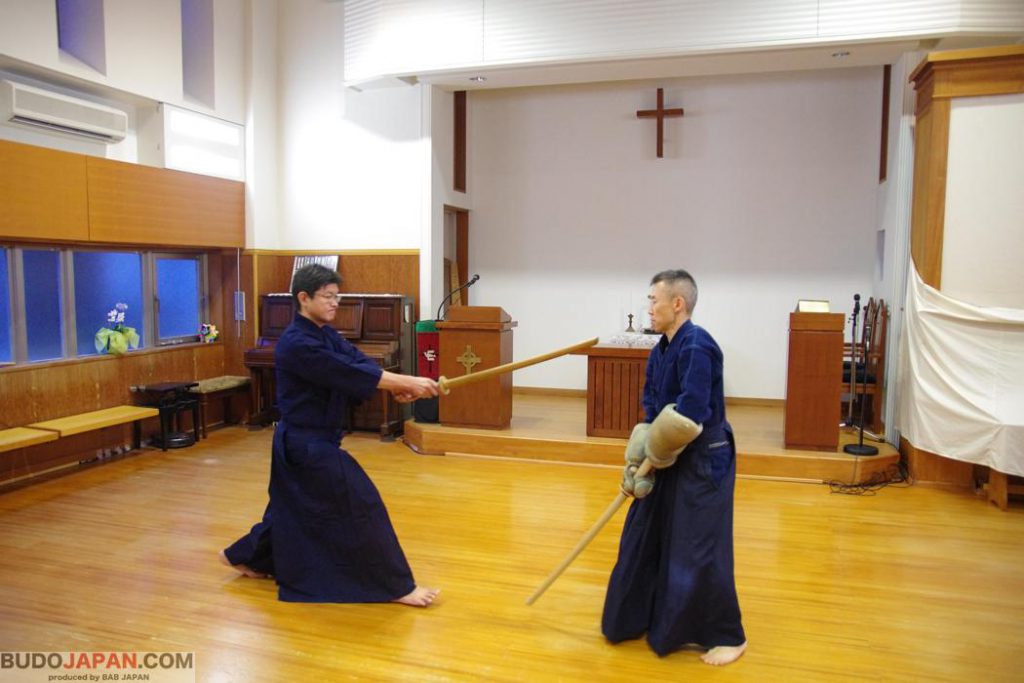
The third kumitachi, Tsuba Wari
When doing kiriotoshi, shikata cuts and moves forward making a bigger circle than uchikata; the most imortant part of the kiriotoshi technique is for shikata to move his sword in a trajectory as if wanting to split uchikata’s sword in two. Also important is the addition of a small rotation of the palms that allows him to use his sword’s ridge or its curvature in a manji movement and make his opponent’s sword’s trajectory slip to the side. At the moment the two swords are crossed by using the rotation of the force towards various directions, you deflect the opponent’s force to the side and change the trajectory of his sword; his sword dies, and you, with a living sword, manage to control him.
“The kiriotoshi of Hitotsu Gachi is a rotation on the vertical plane whereas the manji of Mukae Zuki and Gedan Kasumi is a rotation on the horizontal plane. In kiriotoshi, you meet your opponent’s technique using a rotation of the force and cut down his sword forcing it to slip to the side. The positioning of your sword in your posture, creates a sphere which can repel your opponent’s sword whichever direction it comes from –perhaps such an image helps explaining it.”
Starting with one sword, returning to one sword
Manji is created using the hands and their grip on the sword; still, in Itto-ryu, all movements involve footwork. “True right foot, true left foot goes the teaching and it means that at the instant you hit, the back foot must always be pulled up to follow the front foot; if after performing a technique, your back foot is drawn to the front you can move on to the next movement without a pause and your techniques become a never ending circle, a “junkan mutan”. The same goes in the case of kiriotoshi as well: when it happens, you always need to pull the back foot forward. The footwork is not predetermined though: what is important is to perform kiriotoshi using a footwork that matches your body type and your personal characteristics.
 A kiriotoshi performed freely with a smooth circular motion in the front and a left-right manji will make the opponent’s sword slip to the side; it is important at that time, not to perform the movement disjointed, with the hands only but, making small movements of the feet, to use your sword employing the whole body. When practicing the kumitachi, uchikata is wearing a pair of gauntlets particular to Itto-ryu, called “onigote”. After shikata has done kiriotoshi to his sword, uchikata raises his onigote over his head and shikata cuts them, ending the kumitachi; shikata’s posture at the time he is cutting the kote must be the same as it is when performing kiriotoshi. You are cutting the onigote as if you are doing kiriotoshi and you are doing kiriotoshi as if you are cutting the onigote: you aren’t just hitting the opponent but, putting on your sword the weight of your body and while bringing up your rear foot, you cut the onigote. Paying attention to the sensation you have at this particular moment you practice kiriotoshi again and again.
A kiriotoshi performed freely with a smooth circular motion in the front and a left-right manji will make the opponent’s sword slip to the side; it is important at that time, not to perform the movement disjointed, with the hands only but, making small movements of the feet, to use your sword employing the whole body. When practicing the kumitachi, uchikata is wearing a pair of gauntlets particular to Itto-ryu, called “onigote”. After shikata has done kiriotoshi to his sword, uchikata raises his onigote over his head and shikata cuts them, ending the kumitachi; shikata’s posture at the time he is cutting the kote must be the same as it is when performing kiriotoshi. You are cutting the onigote as if you are doing kiriotoshi and you are doing kiriotoshi as if you are cutting the onigote: you aren’t just hitting the opponent but, putting on your sword the weight of your body and while bringing up your rear foot, you cut the onigote. Paying attention to the sensation you have at this particular moment you practice kiriotoshi again and again.
The important elements of this practice are the principle of the forward rolling wheel (or “sharin zenten”) that makes the movement of the sword circular, the manji created by the hands’ grip on the sword that constructs a sphere of protection, the footwork that drives the movement of the sword and the onigote that build the power of kiriotoshi. Through the study of the 50 kumitachi kata, the practitioner practices many different types of kiriotoshi and in the end, he returns one more time to the beginning, to Hitotsu Gachi.
The Itto-ryu Kumitachi and kiriotoshi as seen through the eyes of Uchikata and Shikata
The legacy of Takemi Sasamori soke: Itto-ryu’s techniques and ideas
Whatever technique the enemy uses, using the principle of the circular movement and without muscling in, you use your sword techniques in one beat and control him. Kiriotoshi is a technique guaranteed to kill but at the same time it cuts away the practitioner’s own malicious thoughts and polishing his mind and body. “Sasamori sensei would teach kiriotoshi as a ‘round and soft technique’ and he would also say that ‘a circle is an aggregate of pointed angles’: hidden in the round and soft circle are sharp techniques. Itto-ryu has this dual aspect and sensei himself, having lived his life in a “round and soft” way i.e. being amiable and gentle was an embodiment of kiriotoshi.
As for me, valuing greatly Itto-ryu and the ideas that Sasamori sensei left to us, I want to help educate and bring to society people who can put these ideas into practice. Although this art was developed to annihilate an enemy, if we sublimate it we can use the idea behind kiriotoshi in our society. By doing kiriotoshi, by cutting out the unhealthy parts in our heart and mind with a “round” calmness and softness we can contribute to a world of harmony and peace. My wish is for Reigakudo to bring to society people of these qualities.”
■ Ono-ha Itto-ryu, Reigakudo Dojo, 155-0032, Daizawa 1-13-2, Setagaya-ku, Tokyo
Tel. 03-3412-6986, Email: ittoryu.reigakudo@gmail.com
(*) I would like to thank my senior in Ono-ha Itto-ryu Mark Hague for going over this translation, pointing out shortcomings and offering alternatives. His help has been as great and appreciated as it is on the practice floor of the Reigakudo.
(**) Despite its obvious negative connotations in the West, the symbol “卍” or “swastika” in Sanskrit has been used widely in religions and spiritual practices both in East Asia and in other cultures for centuries. In Japan it’s synonymous with Buddhism and frequently appears on maps to denote the location of a Buddhist temple. In Buddhism, as well as in other traditions and cultures it is related to the idea of eternity hence the Japanese pronunciation “manji” which is often written with the characters “万字” meaning literally “the character of 10,000” and with “10,000” being synonymous to “innumerable” or “eternal”. (Trans.)
Related article:Ono-ha Itto-ryu’s Takemi Sasamori: A tribute from abroad
Related article:Ono-ha Itto-ryu:One sword to rule them all
Related article:Principles of Budo: Ono-ha Ittō-ryū
 About the translator
About the translator
Grigoris Miliaresis has been practicing Japanese martial arts since 1986. He has dan grades in judo, aikido and iaido and has translated in Greek over 30 martial arts’ books including Jigoro Kano’s “Kodokan Judo”, Yagyu Munenori’s “The Life-Giving Sword”, Miyamoto Musashi’s “Book of Five Rings”, Takuan Shoho’s “The Unfettered Mind” and Donn Draeger’s “Martial Arts and Ways of Japan” trilogy. Since 2007 his practice has been exclusively in classic schools: Tenshin Buko-ryu Heiho under Ellis Amdur in Greece and Kent Sorensen in Japan and, since 2016, Ono-ha Itto-ryu under 17th headmaster Sasamori Takemi and 18th headmaster Yabuki Yuji.
http://about.me/grigorismiliaresis














